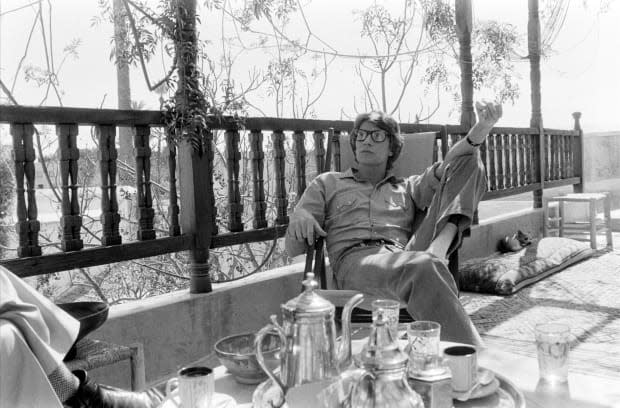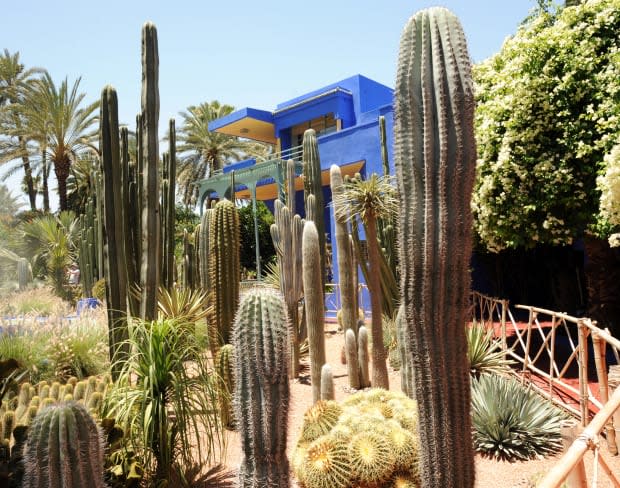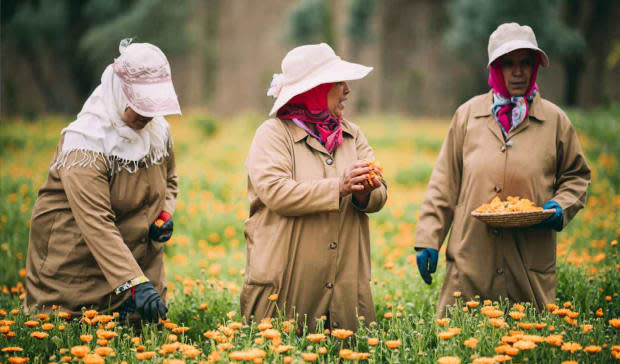YSL Beauty's Mission-Driven Presence in Morocco Honors the Legacy of the Designer Himself
- Oops!Something went wrong.Please try again later.
- Oops!Something went wrong.Please try again later.
With legacy designer brands — and their beauty spinoffs in particular — we can forget that there was once a living, breathing person behind the name. So many of these big labels are concerned exclusively with hitting sales goals, getting innovative products to market ahead of competitors and creating star-studded marketing campaigns. It's rare to see one that's also making an effort to honor the history and heritage of the designer whose name it carries.
Of course, YSL Beauty cares about those sales goals, innovative products and star-studded campaigns. (Zoë Kravitz! Lil Nas X! Lila Moss! Danielle of NewJeans! Indya Moore! To name just a few.) But behind those flashy images of Dua Lipa posing with glossy bottles of Libre perfume, the brand is also establishing itself as a mission-driven business, investing in responsible agriculture, sustainable ingredient cultivation, ecological conservation and reforestation in areas of the world that need it most.
All of these efforts are an attempt to not just cater to growing consumer demand for more mindfully produced, environmentally conscious beauty products: It also carries on the legacy and values of Yves Saint Laurent, the person.
In 1966, when Saint Laurent was 33 years old, he visited Morocco for the first time. It was a story of love at first sight: The city of Marrakesh became his escape from his primary residence in Paris, his home away from home and a powerful source of inspiration in his life and design aesthetic.
"Marrakesh was, for Yves Saint Laurent, a place where he celebrated a perfect balance between reality and imagination. [He called it] 'a magical, pink and quiet atmosphere,'" Laurence Benaïm, author of Yves Saint Laurent: A Biography, tells Fashionista. "Marrakesh was a rebirthing place for Yves Saint Laurent, a place where he used to reinvent himself, where he celebrated the colors of the world."
She recalls the profound effect that initial trip had on Saint Laurent, noting that Marrakesh became "more an aesthetic revelation than a destination," for the designer: "He used to come to Marrakesh two or three times a year, and [would] draw his couture collection there. He drew inspiration from the sky, from nature and from light."

Photo: Reginald Gray/WWD/Penske Media via Getty Images
Just a year after that initial visit, he and partner Pierre Bergé bought their first home in the city. They would subsequently go on to acquire the "Pink Villa" in 1973, then the Villa Majorelle, in the iconic Majorelle Gardens, which would become Saint Laurent's creative retreat and personal oasis throughout much of his life.
Originally conceived of by French painter Jacques Majorelle, the Majorelle Gardens extend over 9,000 square meters in the city of Marrakesh, enclosed by outer walls. Over the course of 40 years, the artist carefully planted and expanded the garden, accenting it with boldly colored buildings and fountains, Moorish influences and Art Deco sensibilities. When the gardens came under the threat of destruction by hotel developers in 1980, Saint Laurent and Bergé swooped in to save it, purchasing the site and moving into Majorelle's former home on the property, which they renamed the "Villa Oasis." It was their goal to preserve and maintain the grounds, and that legacy has carried on through today: The Majorelle Gardens have since become a historic public landmark and museum, welcoming visitors from all over the world.
"Saint Laurent loved gardens and flowers. He had a specific relation with gardens — they kept him inspired," says Benaïm. "They were, for him, this quintessential expression of beauty."

Photo: Abdelhak Senna/AFP via Getty Images
In 2019, nearly 40 years after Saint Laurent purchased the Majorelle Gardens, YSL Beauty followed in those footsteps of environmental and cultural conservation, establishing the Ourika Community Gardens.
Located in the Ourika Valley at the foot of the Atlas Mountains — about 30 minutes outside Marrakesh — the YSL Ourika Community Gardens house more than 200 different botanical species indigenous to the region, including lemon and olive trees, roses, marigolds, irises and saffron. They cover 20,000 square meters, designed by landscape artists Éric Ossarta and Arnaud Maurières.
These gardens are crucial to YSL Beauty's entire product range: The brand cultivates and sources raw materials there that appear throughout its many skin-care, fragrance and color cosmetics formulations.
"Our objective is by 2025 to have in all new products launched feature [at least] one ingredient coming from our different gardens here," says Caroline Negre, the global sustainability and scientific director for YSL Beauty. "So far, [we've achieved that] for skin-care and cosmetics products."
Some examples: the jasmine extract in the All Hours Foundation, the saffron pistils in the Or Rouge range, the pomegranate extract that serves as an antioxidant in the Rouge Volupté Shine lipstick. The brand also has a dedicated botanical research team that works to identify potential uses and benefits of various plants grown at the Ouirka Community Gardens.
"We know that Saint Laurent drew so much inspiration from nature here in Morocco; now, we draw inspiration here to create product," Negre adds. "Going back to the land of Mr. Saint Laurent is key for us."
In the gardens, the brand makes an effort to employ sustainable agricultural methods, such as regenerative practices and upcycling; when raw materials are harvested, their byproducts are often used as fertilizer on the grounds, for example. But it's a philanthropic initiative, as well as an environmental one: As part of what the brand calls its "responsible supply model," YSL Beauty established a social program, through which the garden is maintained by a cooperative of 32 local Berber women, who gain educational and economic opportunities, as well as a sense of autonomy through this program. According to YSL Beauty, in the last three years, the cooperative has doubled its revenue.
All of this, according to Saint Laurent's biographer, speaks to the legacy of the designer himself.
"The Ouirka Community Gardens are a living tableau — I can feel YSL there, his soul and love for supernaturalist vision of nature," says Benaïm. "It's an extraordinary project, a dream that became reality with a special sustainable commitment, a breathtaking explosion of essences, plants and flowers that celebrates raw inspiration. It's the absolute Yves Saint Laurent legacy."
It's not just the vegetation that evokes Saint Laurent's legacy; it's also the regard for the community of women the gardens employ.
"Yves Saint Laurent cared about empowering women: He allowed them to be what they are, to assume the complexity of being in this world, to celebrate their difference against uniformity and intolerance," she says. "I'm impressed by the way YSL Beauty is working toward the future with the respect of the past, particularly in the Ourika Community Gardens."

Photo: Courtesy of YSL Beauty
In addition to establishing its own community gardens and local cooperative to cultivate them, YSL Beauty works with Re:Wild, an NGO established by conservation scientists (and Leonardo DiCaprio) to protect biodiversity through rewilding. Rather than simply focusing on conservation, it identifies areas impacted by climate change and aims to restore ecosystems and create protected areas while partnering with locals to maintain cultural traditions and establish longevity in these efforts.
YSL Beauty has partnered with Re:Wild to protect and restore 100,000 hectares of land — an area almost 10 times the size of Paris — where it sources its ingredients (in Haiti, Madagascar, Indonesia and Morocco) by 2030. In the Ourika Valley, in particular, desertification is the key concern; the YSL Beauty Ourika Community Gardens are one effort the brand has undertaken in the area, but it's also worked to plant trees and restore arid land throughout the region. Since it began these efforts in 2017, YSL Beauty has planted more than 125,000 trees in an effort to combat rising temperatures, deforestation and natural disasters.
"[YSL Beauty] wanted to use their voice to speak to their audience about biodiversity, which most people run from because it's a complex, intangible and complicated thing to talk about," says Dr. Robin Moore, Re:Wild's vice president. "The fact that they want to embrace it and not shy away from it, as well as have an impact on the ground, is really appealing for us, because to turn this around and to rewild our earth, it's going to take all of us. We can't just have the conservation organizations in their own little bubble. We need brands like YSL Beauty, individuals, companies, organizations and governments. We all need to be working together toward shared goals."
For Negre, the Re:Wild initiative is a clear homage to Saint Laurent himself. "It's carrying on Saint Laurent's passion for connecting consumers to mission," she says, recalling a famous quote of the designer's: "I participated in the transformation of my era. I did it with clothes, which is surely less important than music, architecture, painting. But whatever it's worth, I did it."
This outlook is the driving force behind YSL Beauty's current efforts, she argues.
"We're saying, 'Okay, people are more and more aware that biodiversity is being threatened, so we need also to go in this direction — because we're here to contribute to the changing of our era.'"
Disclosure: YSL Beauty paid for my travel and accommodations in Morocco to visit Saint Laurent's home and private gardens in Marrakesh, as well as the brand's Ourika Community Gardens. The brand also coordinated access to the sources interviewed for this story, which were in some cases conducted with the help of a translator.
Please note: Occasionally, we use affiliate links on our site. This in no way affects our editorial decision-making.
Never miss the latest fashion industry news. Sign up for the Fashionista daily newsletter.
